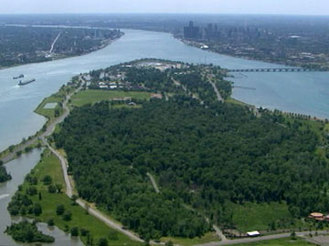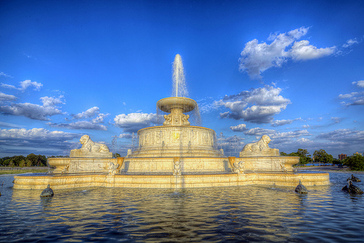Belle Isle Park - Detroit, MI
The largest urban island park in America resides within the city limits of Detroit. Belle Isle Park is a 982-acre oasis of open space within the city of Detroit. It is located just a few miles northeast of downtown in the Detroit River, which separates the United States from Canada. The MacArthur bridge allows access from the mainland of the Detroit side of the river. The bridge is pedestrian-friendly, so the park is accessible to anyone who desires to visit it. The park has been a consistent attraction for a city that has experienced more than its fair share of troubles, particularly in the latter half of the twentieth century and beyond.
Detroit has lost more than half its population from its peak period in the 1950s, when the total was over 1.9 million. As of 2010, the population had dropped all the way to around 713,000, a decline of over a million people. The city has lost more population than it currently has since 1950, largely due to the decline of the automobile industry. The ramifications of this decline are widespread and mostly beyond the scope of this article. It is not an easy topic to digest, discuss, or tackle. However, Belle Isle Park has managed to remain somewhat of a bright spot within the city throughout much of this turmoil. It provides an incredible outlet for city residents to escape the realities of living in a city mired in such a state. Recreation, exercise, and cultural attractions are abound throughout the park, all adding to quality of life indicators for city residents. Various paths and roadways wind throughout the park, providing relatively easy access to most of the park's 982 acres. The park itself is a sublime mix of natural beauty mixed with architectural and landscape design.
Detroit has lost more than half its population from its peak period in the 1950s, when the total was over 1.9 million. As of 2010, the population had dropped all the way to around 713,000, a decline of over a million people. The city has lost more population than it currently has since 1950, largely due to the decline of the automobile industry. The ramifications of this decline are widespread and mostly beyond the scope of this article. It is not an easy topic to digest, discuss, or tackle. However, Belle Isle Park has managed to remain somewhat of a bright spot within the city throughout much of this turmoil. It provides an incredible outlet for city residents to escape the realities of living in a city mired in such a state. Recreation, exercise, and cultural attractions are abound throughout the park, all adding to quality of life indicators for city residents. Various paths and roadways wind throughout the park, providing relatively easy access to most of the park's 982 acres. The park itself is a sublime mix of natural beauty mixed with architectural and landscape design.
|
The park has a long history and is listed on the U.S. Register of National Historic Places. The island has been preserved since the mid 1800s, and a design plan for the park was created by the famous Frederick Law Olmsted in the 1880s. However, the park was not fully implemented in his vision, although he did heavily contribute. The park as it currently exists features numerous trails, paths, and recreation and sports facilities, but also several cultural attractions. The Belle Isle Nature Zoo is a popular attraction as well as the Dossin Great Lakes Museum, which focuses on Great Lakes shipping and maritime history. Two other popular attractions are the James Scott Memorial Fountain, which dates back to 1925, and the Belle Isle Conservatory. A greenhouse and botanical garden comprise the Conservatory, which has been in existence since 1904 and is free to visit for everyone.
|
A key components of the park's current condition and even existence is the work of non-profit and volunteer groups. They have taken the initiative to care for the park in ways in which the city itself has been unable. For example, the park was forced to close the park's popular aquarium in 2005 due to funding and operational issues. However, the work of these groups led an effort that resulted in a successful reopening in 2012. The aquarium fully run by volunteers. Overall, the park is a monument to the city's glorious past as well as its promise. It is the public park showcase of what once was one of the top American cities. However, the park's future is constantly in question as Detroit continues to struggle with economic and management problems. But the park still plays an incredibly valuable role in city life, and is yet another example of how non-profit, private, and volunteer groups can maintain and protect cherished public spaces.



